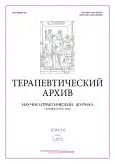The role of artificial intelligence in assessing the progression of fibrosing lung diseases
- Authors: Speranskaia A.A.1
-
Affiliations:
- Pavlov First Saint Petersburg State Medical University
- Issue: Vol 94, No 3 (2022)
- Pages: 409-412
- Section: Original articles
- URL: https://journals.rcsi.science/0040-3660/article/view/106462
- DOI: https://doi.org/10.26442/00403660.2022.03.201407
- ID: 106462
Cite item
Full Text
Abstract
Introduction. The widespread use of artificial intelligence (AI) programs during the COVID-19 pandemic to assess the exact volume of lung tissue damage has allowed them to train a large number of radiologists. The simplicity of the program for determining the volume of the affected lung tissue in acute interstitial pneumonia, which has density indicators in the range from -200 HU to -730 HU, which includes the density indicators of "ground glass" and reticulation (the main radiation patterns in COVID-19) allows you to accurately determine the degree of prevalence process. The characteristics of chronic interstitial pneumonia, which are progressive in nature, fit into the same density framework.
Аim. To аssess AI's ability to assess the progression of fibrosing lung disease using lung volume counting programs used for COVID-19 and chronic obstructive pulmonary disease.
Results. Retrospective analysis of computed tomography data during follow-up of 75 patients with progressive fibrosing lung disease made it possible to assess the prevalence and growth of interstitial lesions.
Conclusion. Using the experience of using AI programs to assess acute interstitial pneumonia in COVID-19 can be applied to chronic interstitial pneumonia.
Full Text
##article.viewOnOriginalSite##About the authors
Aleksandra A. Speranskaia
Pavlov First Saint Petersburg State Medical University
Author for correspondence.
Email: a.spera@mail.ru
ORCID iD: 0000-0001-8322-4509
д-р мед. наук, проф., проф. каф. рентгенологии и радиационной медицины с рентгенологическим и радиологическим отделениями
Russian Federation, Saint PetersburgReferences
- Inui S. Radiology: Cardiothoracic Imaging, 8 April 2020. Available at: https://www.researchgate.net/journal/Radiology-Cardiothoracic-Imaging-2638-6135. Accessed at: 24.02.2022.
- Han X, Fan Y, Alwalid O, et al. Six-month Follow-up Chest CT Findings after Severe COVID-19 Pneumonia. Radiology. 2021;299(1):E177-86. doi: 10.1148/radiol.2021203153
- Flaherty KR, Wells AU, Cottin V, et al. Nintedanib in Progressive Fibrosing Interstitial Lung Diseases. N Engl J Med. 2019;381(18):1718-27. doi: 10.1056/nejmoa1908681
- Cottin V, Wollin L, Fischer A, et al. Fibrosing interstitial lung diseases: knowns and unknowns. Eur Respir Rev. 2019;28(151). doi: 10.1183/16000617.0100-2018
- Raghu G, Collard HR, Egan JJ, et al. An official ATS/ERS/JRS/ALAT statement: idiopathic pulmona ry fibrosis; evidence based guidelines for diagnosis and management. Am J Respir Crit Care Med. 2011;183:788-824.
- Сперанская А.А., Новикова Л.Н., Двораковская И.В., и др. Лучевая и морфологическая картина фиброзирующих болезней легких: от ранних признаков до исхода. Лучевая диагностика и терапия. 2020;11(2):89-98 [Speranskaya AA, Novikova LN, Dvorakovskaya IV, et al. Radiation and morphological picture of fibrosing lung diseases: from early signs to outcome. Diagnostic Radiology and Radiotherapy. 2020;11(2):89-98 (in Russian)]. doi: 10.22328/2079-5343-2020-11-2-89-98
- Maldonado F, Moua T, Rajagopalan S, et al. Automated quantification of radiological patterns predicts survival in idiopathic pulmonary fibrosis. Eur Respir J. 2014;43(1):204-12. doi: 10.1183/09031936.00071812
- Jacob J, Bartholmai B, Rajagopalan S, et al. Mortality prediction in idiopathic pulmonary fibrosis: evaluation of automated computer-based CT analysis with conventional severity measures. Eur Respir J. 2017;49:1601011. doi: 10.1183/13993003.01011-2016
Supplementary files










